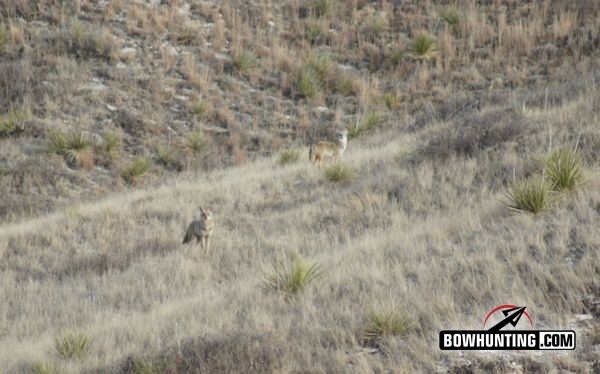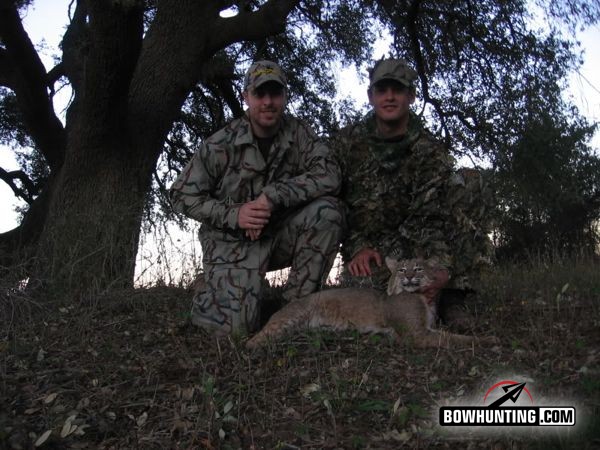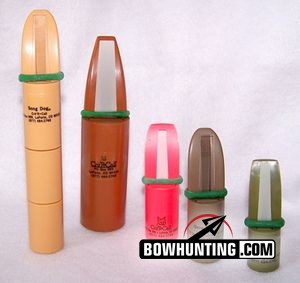LAST UPDATED: May 8th, 2015
Many bowhunters amid their off-season are filling out their NCAA basketball brackets, but the month of March brings me a whole new “March Madness.”
The March Madness I’m referring to is bowhunting predators. The coyote breeding season is the probably the most difficult time of year to call, fortunately, it is nearing completion for the majority of the continental United States and in some places has most likely been over for a couple of weeks. No different than a whitetail buck post-rut, coyotes main objective has switched from mating to eating and it’s an excellent time for bowhunters to test their skills at fooling a Wiley into thinking they’re an easy meal.
A mating pair of Coyotes in Southeastern Wyoming
I’ve always said that if I couldn’t bow hunt big game animals, I wouldn’t be “settling” to call predators because I love it. Calling predators whom have better sight, hearing and sense of smell than a whitetail is a challenge with any weapon, let alone archery tackle. The deck is stacked against any bowhunter when it comes to calling predators, but that very fact can provide one of the most rewarding hunts imaginable.
It’s possible that predator hunting is one of my favorite activities due to the general ease of finding places to hunt. In my personal experiences, there are more ranchers and farmers that grant permission to call predators than any other type of hunting. Most of us are deer hunters at heart, so let’s be honest, what better way is there to get your foot in the door with a landowner? In the past few months I’ve met several ranchers that have offered me the privilege to hunt coyotes on their property and I feel fairly certain that there may be opportunities to hunt deer and antelope on their property this coming Fall, that is, if I do my job and show them that I am a responsible and respectful guest on their property.
The Keys to Success:
Be patient, be still, and call into the wind. Calling into the wind (in my opinion) is by far the most important when we’re talking about bowhunting. The ultimate goal is to get the animal into 40 yards, not 400. A coyote that is 300 yards from you, down wind, is killable with a rifle and probably won’t smell you before the bullet gets there, but inside of a 100 yards you most likely won’t see them or if you do it will be for a split second. Next on the importance list, being still. We have to keep in mind that the predators we’re calling are looking for the source of the sound, and by finding that source is how they survive. This is where a hands free or remote controlled caller like the FoxPro series can come in extremely handy by diverting the animal’s attention away from the shooter/caller. Things that eliminate movement like having an arrow nocked and your bow already sitting vertical can be the difference between bow kills and busts. Finally, be patient. Just like deer, coyotes and (especially) bobcats can be extremely cautious when their coming to find a free meal. I’m not sure who it was, but someone has familiarized them with the phrase, “if it’s too good to be true, it probably is.” Be patient, on average I’ll spend 20 minutes at each stand location, and generally I’ll call for 30-45 seconds and then wait for a minute or two before calling again. Hunters that call in late January and February spend more time because they’re howling instead of using an “animal in distress” call.
A beautiful Texas Tom killed in 2007
The Calls:
When we think of “predator calls” most of us automatically think of a high-pitched screaming rabbit and whi le this is definitely the most popular sound, it’s far from the only one that will produce results. The way I figure out which call I’m going to start with is to figure out what would be the primary food source in the area. In areas with lots of hardwoods, a Woodpecker or Blue Jay in distress call can produce great results. Where I hunt, there are no Blue Jays and a Jack Rabbit or a Cottontail are what I reach for first. The one call that I feel every predator hunter should have on them at all times is a mouse squeaker, like that out of a dogs chew toy (or simply be able to lip squeak at any given time).
There are literally hundreds of predator calls on the market and fortunately most of them will probably work. There are three basic styles of calls: open reed mouth call, closed reed mouth call and electronic calls. The open reed calls are my personal favorite because they produce (to my ears) a very pure sound, they’re also very versatile in the pitches that you can create with the exposed and moveable reed. Closed reed calls are extremely simple to use… just blow. They don’t have the versatility of an open reed call. Electronic calls have come a long way since Johnny Stewart came out with their electronic caller some 25 years ago, you don’t have to carry a cassette tape, a speaker, a tape player and a battery pack any longer. There are several electronic calls on the market, but in my opinion the FoxPro Series is light years ahead of the others. They can be operated manually or by long range remote control and they also have decoys that can be controlled by the same remote to give your quarry something to look at other than you. It’s important to have multiple calls in your arsenal for different weather types, wind conditions, etc.
Crit R Calls are my favorite open reed predator calls
A Circe closed reed predator call is adjustable to create Cottontail, Jack Rabbit and mouse squeak sounds
The FoxPro Series of electronic calls give you the versatility to have hundreds of sounds at your finger tips
The Setup:
Calling coyotes is different in every terrain type but they’re all coyotes looking for the same thing and if you follow the three “rules” previously discussed, you’re well on your way to being more successful. My recent move from Oklahoma to Wyoming has changed the way I hunt, 180 degrees. In places like central Oklahoma with thick cover, my favorite method is to back off of the thicket as far as possible while still keeping the “edge” within shooting distance. Coyotes and bobcats alike, prefer the security of the thick cover and are often times more likely to come investigate my distress sound. In Wyoming, that strategy is useless… the sage brush flats provide no such cover. Now I look for hard edges, a rocky out-cropping, a sharp ditch bank or an edge of sage brush that opens into a grass flat. These coyotes are used to being in the open and seeing, well… everything, so hiding myself is the main goal. It is no different than hunting deer, you have to learn your individual properties.
Whether you’re a seasoned predator caller or looking for a new “March Madness,” calling predators is something every bowhunter should try.

 By
By 








